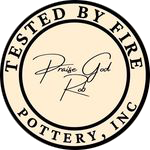Uncategorized
Firing the Kiln
Step 12: Firing the Kiln
It takes 25 or more hours to fire the kilnandwe usually start the firing sometime around 1 p.m. The first part of the firing, which is about five hours, is dedicated to slowly removing any remaining moisture from the ware, latent water and chemically combined water. If all the water in the clay is not driven out before quartz inversion when the body seals itself off, the piece will explode. This is an event which I heard one man describe as massive and catastrophic failure. When a piece or multiple pieces explode, they are like a terrorist with a bomb strapped to themselves taking other pieces with them. When they explode, they send ceramic shards flying around the kiln ricocheting off walls and shelves and landing on plates or in bowls, amplifying the destruction far beyond the original piece that exploded.
Going Slow
Only two of the four burners on my kiln are lit with the smallest flame possible during this initial drying time, but all four blowers are turned on to provide as much circulation of warm air as possible with the intention of keeping the temperature below the boiling point. At 5:00 or 6:00 p.m. I turn on the other two burners with the same amount of pressure as the first two, which is 1 water column of pressure each. Then at 10 pm I turn the pressure up to 3 water column inches of pressure and open the air on the blowers a little more. The blowers are never open completely even when the gas is turned up to 11 water column inches, for two reasons. This is how I keep the air gas mixture in a proper relationship. The firings that I do are called reduction firings which means that I fire my kiln with a fuel rich environment. I have the gas air mixture set so that there is an excess amount of fuel entering the kiln. The excess fuel molecules look for oxygen molecules to facilitate combustion. When there is not enough oxygen available, the fuel steals oxygen molecules from the oxides in the clay and glazes on the pottery in the kiln creating effects that are not possible in an oxygen rich environment.
Yes I Go to Bed
The kiln runs all night at that setting. At 6:00 a.m. the kiln will have reached about 1400 degrees. I go to the studio to turn up the kiln again this time to 6 WC inches and open the air on the blowers a little more. The kiln starts to increase rapidly in temperature and in an hour the kiln will be 1600°. I will put the kiln in reduction by increasing the gas to 11 WC and pushing in the damper. This will establish some back pressure in the kiln, enough to push a flame about six inches out the top peep holes and about four inches out of the bottom peep holes. I have a pyrometer with thermocouple and oxygen sensor on it that tells me the level of reduction in the kiln. I also have cones in the kiln that melt at various points as the kiln increases in temperature. They are a failsafe encase in case my instruments do not give an accurate reading. The cones that I use sit in a cone pack so that they can be seen through the peep holes around the kiln. The cones are numbered 7, 9, 10, 11 and 12. Each cone bends at a specific temperature and gives me a clearer idea of what stage my glazes are in as the firing progresses. The cone temperature chart shows Cone 7 temperature is 2259°, Cone 9 is 2295°, Cone 10 is 2340° and Cone 11 is 2359°. I fire to Cone 10 bending halfway and then begin a soak time of 20 minutes. The soak time flattens Cone 10 and bends Cone 11. Cone 11 and 12 are there to let me know what is going on and if I have gone too far.
The Final Step:
After the soak time, I turn off the gas and blowers then and push in the damper and block the burner ports. It takes two full days for the kiln to cool down enough to open the kiln. There are different theories on this, but I think that slow cooling helps glazes settle some. Faster cooling can cause problems like pieces cracking and glazes crazing or shivering, so I prefer to take it slow. All potters have their preferences as to burners, kiln shelves, fuel and firing times. Every kiln has its own personality, especially kilns that are designed and built by the potter. There are glazes that I use which fire very differently in this kiln than they did in my previous kilns, much to my dismay. I have tried to do everything I can to get the same result, but nothing seems to work. Other glazes work better in this current kiln than they did in the previous kiln. That is part of the beauty and mystery of firing in a kiln you built yourself and in a reduction atmosphere.
